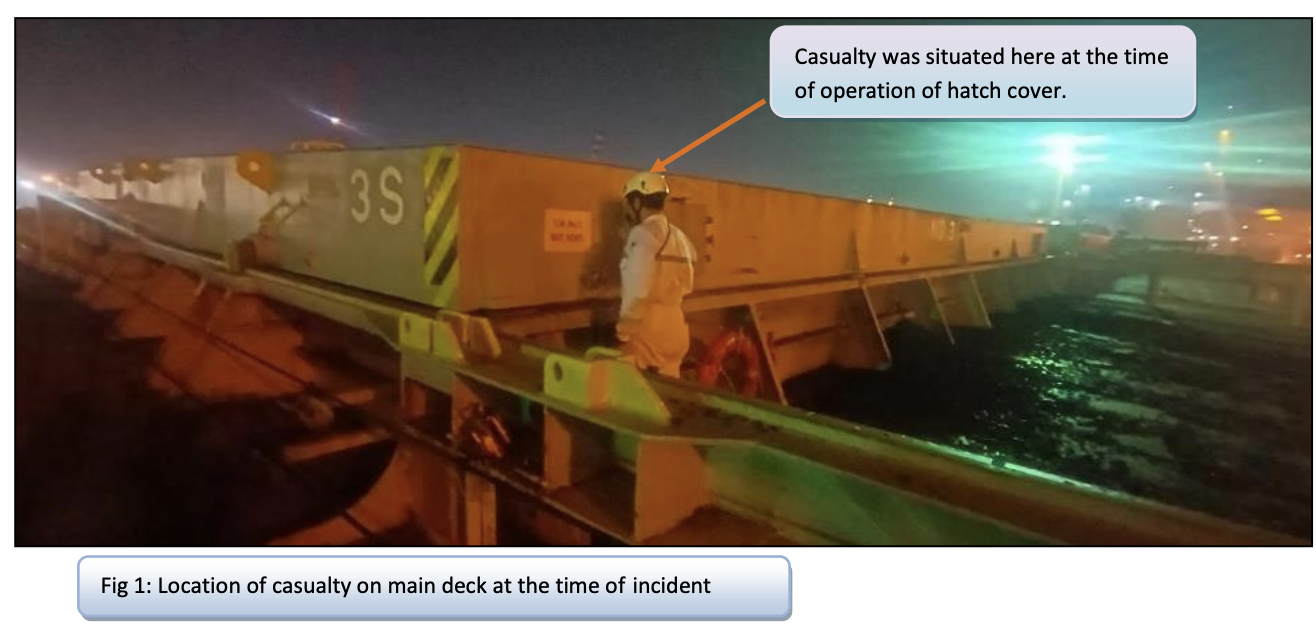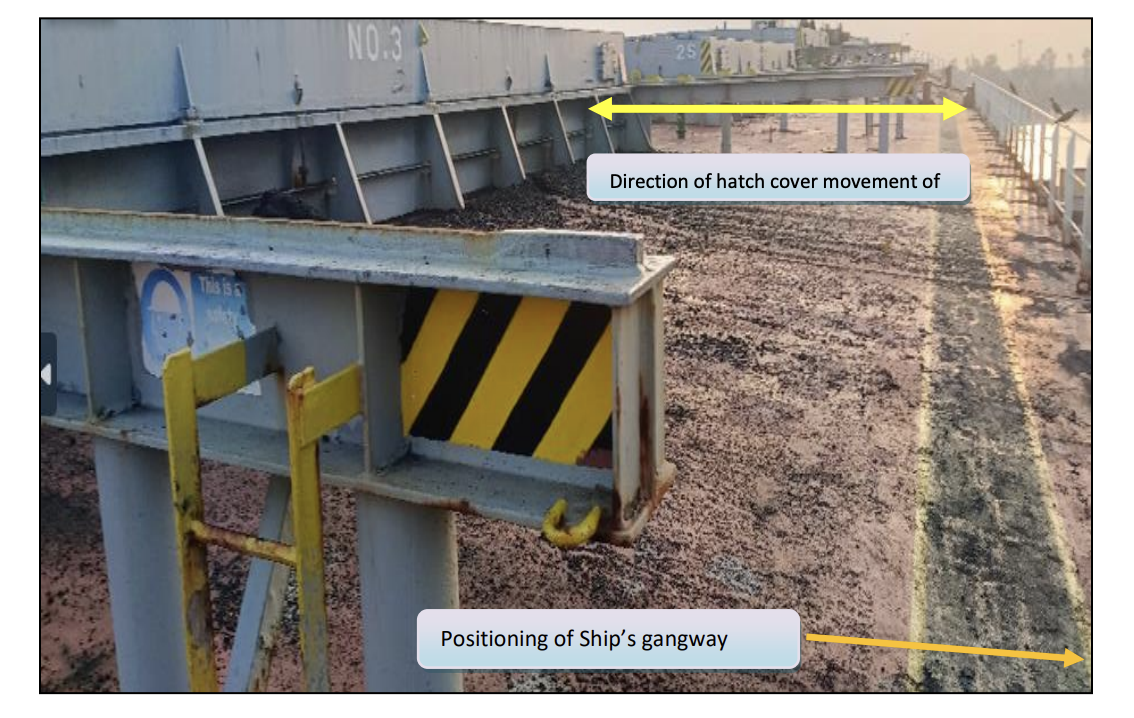Decoding DGS Circular No. 24 of 2024: Strengthening Shipboard Safety, Lessons from Haldia Incident

Strengthening Onboard Security and Safety Protocols: Lessons from the Recent Haldia Port Casualty (Actual Circular Available for Download at the End)
In light of the recent and tragic incident that occurred onboard a vessel berthed at a coal jetty in Haldia, this advisory is issued to strengthen onboard security and safety protocols.
The incident resulted in the unfortunate loss of life, highlighting significant gaps in safety procedures and personnel management.
Incident Overview
On October 4, 2023, a businessman boarded the vessel while it was docked at the coal jetty in Haldia.
Despite being denied access and explicitly instructed to leave the vessel, the individual did not comply and remained in the vicinity of the gangway.
The gangway, which is a crucial access point to the vessel, was located near cargo hold No. 3. At the time, the hatch cover for cargo hold No. 3 was in an open position, extending close to the gangway’s boarding area.
Hatch covers are heavy steel plates used to seal cargo holds, and their operation requires strict adherence to safety protocols due to the potential risks involved.

The sequence of events leading to the casualty is as follows:
- Weather Conditions: As the individual began to descend the gangway, it started to rain. This sudden change in weather prompted the gangway watchkeeper and a duty hand to initiate the process of closing the hatch covers for cargo holds No. 3 and No. 5.
The primary concern at that moment was to protect the cargo from getting wet, which could potentially damage it. - Re-boarding of the Individual: While the hatch cover operation was underway, the individual, who had initially been asked to leave, reportedly returned onboard. Seeking shelter from the rain, the person took cover under the hatch cover of cargo hold No. 3, on the starboard side near the gangway.
This location, being close to the operational area of the hatch cover, placed the individual in immediate danger.
Cause of the Incident
The casualty occurred during the critical operation of closing the hatch cover of cargo hold No. 3. The preliminary investigation identified several root causes and contributing factors that led to this tragic incident:
- Failure in Basic Seamanship: The investigation revealed that only two duty hands were present on deck to handle both cargo and security duties. This inadequate staffing resulted in the gangway being left unattended while the duty hands proceeded to close the hatch covers.
Basic seamanship practices, such as giving a verbal call or using a flashlight to signal in the area before operating the hatch cover, were neglected. Such lapses in standard practices are serious breaches of safety protocols and can lead to fatal consequences, as seen in this case. - Non-Compliance with the Safety Management System (SMS): The investigation further revealed that the safety procedures outlined in the vessel’s Safety Management System (SMS) manual were not followed during the hatch cover operation.
The SMS manual is a critical document that outlines the necessary procedures to ensure safety during various operations onboard. Non-compliance with these procedures indicates a significant failure in adhering to established safety protocols. - Insufficient Staffing Levels: The incident highlighted the issue of insufficient staffing levels on deck at the time of the operation. The lack of adequate personnel meant that the security duty hand had to leave the gangway unattended to assist in closing the hatch covers.
This situation not only compromised the security of the vessel but also led to a breakdown in the chain of command, where critical safety checks and balances were overlooked. - Inadequate Illumination: The investigation also pointed out that the area under the hatch covers was poorly illuminated, especially during dark hours. The available lighting, provided by a forward mast aft-facing floodlight, was not sufficient to ensure visibility in the operational area.
Poor lighting conditions can significantly impair the ability of the crew to safely conduct operations, especially in adverse weather conditions like rain.

Recommendations
In response to the findings of the investigation, the Directorate General of Shipping provides the following recommendations to prevent the recurrence of such incidents and to enhance overall safety onboard vessels:
- Manning the Gangway: The gangway should always be manned, ensuring that no unauthorised persons can board the vessel unnoticed.
During hours of darkness, when visibility is reduced, the gangway should be lifted from the jetty to further reduce the need for constant monitoring and to prevent unauthorised access. - Adequate Personnel on Deck: To ensure safety, security, and operational efficiency, there must always be an adequate number of personnel on deck.
Adequate staffing levels are essential to manage all operations smoothly and to respond promptly to any unexpected situations. - Adherence to Seamanship Practices: Basic seamanship practices, along with the safety procedures outlined in the SMS manual, must always be strictly adhered to.
These practices are the foundation of safe operations onboard and help prevent accidents by ensuring that all crew members are aware of and follow established protocols. - Proper Illumination: It is crucial to ensure that the area between the hatches and underneath the hatch covers is properly illuminated, especially during night operations or in poor weather conditions.
Adequate lighting is essential to provide clear visibility and to help the crew safely conduct operations without the risk of accidents. - Strict Control of Unauthorised Access: The port authorities should enforce strict controls to prohibit unauthorised persons from entering the vessel, especially during odd hours.
Unauthorised access poses significant security risks and can lead to situations where individuals are exposed to danger without the knowledge of the crew. - Controlled Access to Enclosed Spaces: Vessels must ensure that all enclosed and restricted spaces are not accessed unless duly authorised by vessel personnel. Access to these spaces should be tightly controlled and monitored, with all entries and exits being recorded.
Unauthorised access to these areas can lead to serious accidents, as enclosed spaces often contain hazardous conditions. - Comprehensive Security Training for Seafarers: Seafarers should receive thorough education and training regarding their responsibilities in maintaining onboard security.
This training should cover all aspects of security, including how to handle unauthorised personnel, how to respond to emergencies, and how to ensure that all operations are conducted safely.
It also emphasises the need for adequate training for shore personnel engaged by port stevedores to ensure they understand the risks associated with their duties and follow proper safety protocols.
The Actual Circular
Brief Particulars of the Incident Referred to in the Circular
- Incident Name: KAVO ALKYON
- IMO No: 9291121
- Flag: Marshall Islands
- Type of Ship: Bulk Carrier
- Year Built: 2005
- Gross Tonnage: 38,845
- Owners/Managers: FALCON VENTURES
- Classification Society: American Bureau of Shipping
- Cargo: Coal
- Location of Incident: Coal Jetty at Haldia
- Weather Conditions: Slight/Calm
- Date of Incident: 04/10/2023
- Type: Very Serious Marine Casualty
- No. of Fatalities: 1
- Injuries: 0
- Age: ----
- Nationality: Indian
- Personnel Involved: Businessman
- Nature of Incident: Entrapment underneath the hatch cover while it was being closed.
- Location: On the main deck underneath the hatch cover of cargo hold No. 3.
The detailed account of this incident and the subsequent analysis are intended to reinforce the importance of strict adherence to safety protocols and constant vigilance in all onboard operations.
By following the recommendations provided, the maritime community can work towards preventing similar tragedies in the future, thereby ensuring the safety and security of all personnel on board.